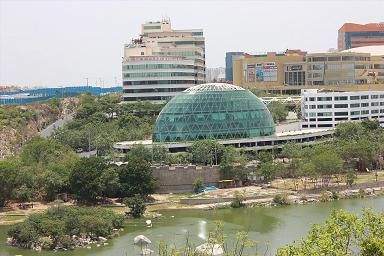Infosys green building experiment reduces energy bills by 38%
Infosys, the multinational IT corporation, has demonstrated the cost effectiveness of energy efficient buildings through an innovative experiment in its Indian office

Infosys, the multinational IT corporation, has demonstrated the cost effectiveness of energy efficient buildings through an innovative experiment in its Indian office.
The company’s office in Hyderabad (pictured right), south India is split into two halves, which are identical except for their energy systems.
Rohan Parikh, head of infrastructure and green initiatives at Infosys, led the way
One half of the building uses a green radiant cooling system and the other half uses conventional air conditioning.
With radiant cooling technology, cold water is pumped through pipes in the walls so there is no recirculation of air.
The results of the experiment have been significant, with the green side recording energy bill savings of around 38 per cent compared to the conventional system in the opposing half.
According to reports, the energy efficient side also cost 1 per cent less to build.
Infosys has reduced has cut electricity consumption by 44 per cent per employee since 2008 and says over the last six years it has cut overall bills as a whole by US$80 million (£48 million).
The Sustainable Energy Association in the UK has claimed that investing in more energy efficient homes could save up to £12.1 billion annually and help achieve national carbon reduction targets.
Singapore is also committed to research and development of energy efficient offices, with a new partnership aiming to help offices use 40 per cent less energy than average using green technology.
Singapore-ETH Centre Future Cities Laboratory (SEC FCL) and the United World College South East Asia (UWCSEA) have formed the partnership and are looking to develop the first commercial project to use the new concept ‘3for2’.
The concept enables developers to construct three floors in the space normally occupied by two, through the use of new technologies and will be used in a new UWCSEA high school building.
As well as saving space it will lead to reduced energy use, incorporating more efficient and space-saving air conditioning systems and LED lighting panels.
The UWCSEA school building is scheduled for completion by mid 2015.
Approximately 60 per cent of electricity consumption in Singapore is due to air-cooling in offices, and the new design could significantly improve the city state’s energy efficiency.
The concept will also be implemented at UWCSEA’s Dover Campus in western Singapore.

